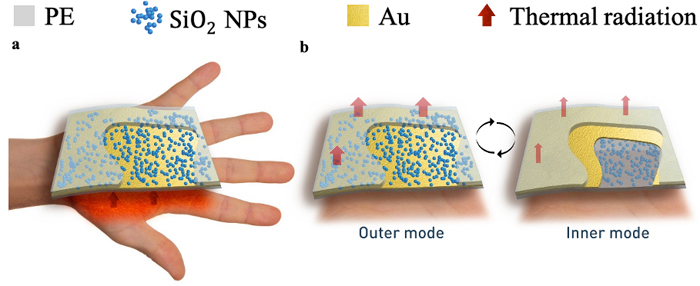Improve the thermal comfort of a textile by controlling its optical properties
One of the ways to limit the energy consumption of our buildings is to improve the thermal properties of the textiles we wear. In this context, we have shown that an asymmetric multilayer structure combining a thin metallic layer sandwiched between two polymer membranes integrating SiO2 particles or different thicknesses, can ensure a skin temperature of 34°C. Thus the association of these 3 elements on a textile support allows to control its emissivity in the medium infrared wavelength range. By playing on the reversibility of the asymmetrical structure, thermal comfort is then obtained for a wide range of ambient temperatures (from 7°C to 16°C).
Schematic representation of the asymmetric fabric. (a) 3D representation of the structure with SiO2 particles randomly distributed in the upper polyethylene (PE) membrane. (b) 3D representation of the two modes of operation of the fabric. The outer mode is obtained when the PE with the particles is oriented towards the environment, the inner mode when the structure is turned inside out.
Improving the radiative heating performance of textiles is becoming one of the most current research topics to reduce the energy consumption used to control the temperature of indoor spaces.
At a normal temperature of 34°C, the human skin emits thermal infrared (IR) radiation in the 5-15µm range (mid-infrared, MIR) with a maximum peak around 9.6µm wavelength. For an individual at rest, infrared radiation accounts for more than 50% of total body heat loss. By controlling the emissivity, transmissivity and reflectivity of infrared radiation from the human body through textiles, the temperature in the space between the skin and the textile (microclimate) can be controlled.
In this context, we propose an asymmetric design for heating functionality in medium and low temperature indoor environments. The structure consists of a thin metal layer sandwiched between two polyethylene (PE) membranes of equal thickness, where SiO2 particles are introduced into one of the two membranes. Thus, we combine the absorption effect of the dielectric particles with the reflective properties of the metal and propose a very efficient thermal management design. By playing with the reversibility of the asymmetric structure, we were able to show a significant widening of the useful temperature range to maintain the thermal comfort.
First, we present the geometry of the fabric and the numerical method used for the electromagnetic calculations. These tools allow us to demonstrate the impact of the insertion of particles on the emissivity of the fabric in the MIR range. After fabrication and characterization, we find good agreement between Fourier transform IR spectra and numerical data. These optical properties are then used to determine the thermal performances of the structure obtained by radiative heating of the fabric complexed to our multilayer and by comparing them to a cotton type textile. For the latter, the thermal comfort of 34°C on the skin is obtained for a range of temperature between 20 and 24°C while it extends from 8.6°C to 13.7°C for our multilayer structure complexed with a classical textile. These results are confirmed qualitatively by thermal camera.
We also studied the question of the membrane’s breathability, a key parameter for worn textiles. Whether using nano porous PE or creating apertures smaller than the wavelength (in our case 5 µm), the optical performance of the structure is not altered.
This work was carried out in collaboration with the UMET and GEMTEX laboratories of the University of Lille in the framework of an Interreg Photonitex contract (2018-2022). It will continue through the ANR-PRCE contract POCOMA in collaboration with the industrial DAMARTEX (2022-2026).
https://onlinelibrary.wiley.com/doi/epdf/10.1002/admt.202101738














